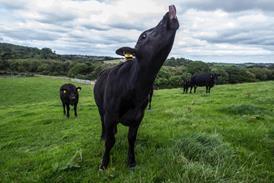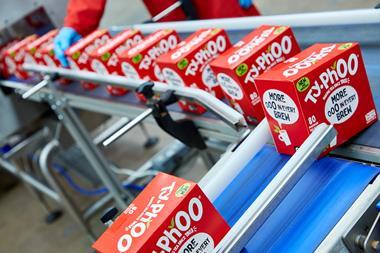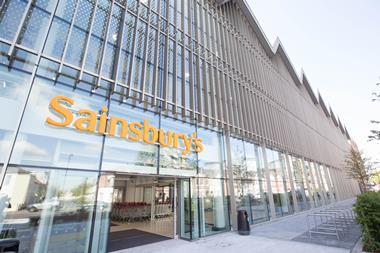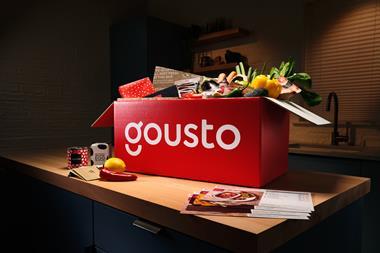TV Choice provides the drama as editorial content is sidelined
TV listings is the most important magazine sector for retailers, with What s on TV and Radio Times selling more copies than any other magazine through news stands, and half of the top 10 best selling magazines falling into this category.
What's on TV, from IPC's tx division, has outsold every other news stand magazine for the past two years, notching up 1,707,655 in the latest ABCs. Launched in 1991, the title appeals to a diverse audience although its core readership is made up of budget-conscious C1C2D females.
However, the real story in this sector at the moment is H Bauer's TV Choice, which went straight in at number three in the sector following its September launch. Top titles What's on TV and BBC Worldwide's Radio Times, both lost sales to the new entrant although Bauer's own TV Quick took much of the blow with a 20% downturn in year-on-year sales followed by IPC's TV Times, down 14.6% in the same period.
"I think we took IPC by surprise they had been looking after the TV sector up until then," says TV Choice's editor, Lorie Miles, who refers to her magazine as "the biggest launch in 11 years". Certainly TV Choice had a dramatic effect on the sector, posting a remarkable 784,904 in its first ABCs.
Miles puts TV Choice's stellar performance down to a few key points: "We saw that there was a market for a TV magazine with minimum editorial and just TV listings. Not everyone wants the whole bundle of stuff you get with TV Times. It is competitively priced and there is a massive market for cheap listings."
Price is a key issue in this sector, and one Bauer emphasised in the TV ads that accompanied TV Choice's launch, tagging it the cheapest TV listings magazine on the market (at 38p) and prompting IPC to initially slash the cover price of What's on TV from 50p to 35p.
However, Caroline Ward, managing director, IPC tx, insists What's on TV readers look beyond cover price. "Our readers look for value for money, not just the cheapest product. Even with a 2p price differential What's on TV is selling a million copies more than TV Choice."
Ward also points out that although the cut price approach can put sales figures up, this is not necessarily good news for retailers. "Retail revenue has been badly affected with margins taking a hefty downturn," she says of the cut-price sector.
Nevertheless, TV Choice commands a massive readership and the good news for grocery retailers is that they don't have to share these consumers with WH Smith. Says Miles: "WH Smith refused to take us that means our readers have to buy the magazine through supermarkets or independents, something all grocery retailers should be aware of."
The design of TV listings magazines is another crucial factor in sales as readers look for a clear and accessible guide to an unprecedented number of channels.
Says Miles: "A large part of TV Choice's success is its superior design. It took us a year to research how we should lay out the listings. In addition, we were the first to take digital really seriously giving it more space than the competition."
Following the TV Choice launch, new designs were rolled out in the sector in the bid to stay ahead.
In June, What's on TV was given a "cleaner, glossier look" alongside new film and soap sections and extra digital listings. A few months later, TV Times embarked on an "aggressive programme of development and growth", refocusing its celebrity coverage and adding a new digital listings package. IPC also put a £2m support package behind the new-look brand.
With the increasingly popularity of digital TV, the established digital listings magazines are seeing excellent growth. IPC's TV & Satellite Week, which commands a readership of young B, C1 and C2s stands out among the competition with Ward describing it as a "star performer".
She says: "We have seized the huge opportunity opened by the advent of digital TV and its new ABC of 211,505, is not only up 6.5% year on year but 17.2 % period on period. This makes it the fastest growing title in the market, with its rate of growth even outstripping the rate of take-up of digital TV."
The more traditional Radio Times has also recognised the growing importance of subscription channels. Managing editor Roger Hughes says: "In the longer term we will be looking at our coverage of satellite and cable some time next year there will be some changes."
However, Hughes says the strength of Radio Times, with its core ABC1 readership, lies in its point of difference from the competition and says the magazine will always be selective: "We place emphasis on editorial content and, of course, we're the only magazine in the sector to take radio seriously. The emphasis is on guidance and on giving the reader a helping hand with what's on offer on television and radio."
Another point of difference for Radio Times is its covers, which it uses to differentiate itself on shelf. Says Hughes: "There are the core numbers of readers who would buy Radio Times every week regardless of who is on the cover, but floating buyers will certainly be influenced by the cover. We use high quality photography the content of the cover alone sets it apart from other magazines in the sector."
Certainly covers are crucial to sales in this sector. IPC tx's Ward says: "The cover is very important. For What's on TV, for example, a good cover, one with popular soap stars in a topical story that people are talking about, is worth its weight in gold. The cover is what draws new consumers to the market so display is crucial. This market is incredibly valuable to retailers. There is real benefit to be gained by full facings."
Display becomes even more important at Christmas as the festive period brings a large number of one-off consumers into the market and most publishers of weeklies produce a "double issue" covering Christmas and New Year viewing.
BBC Worldwide says the Radio Times Christmas issue is the biggest revenue earning event in the entire magazine market with sales typically rising by two and a half times last year's Christmas issue sold nearly three million copies. This year Radio Times has produced a colour wallchart to help retailers keep track of its publication dates in the run-up to Christmas.
TV Times also saw sales more than double last Christmas and IPC says its three tx titles all saw significant increases in sales, selling 4.5million copies between them and generating £5.5m retail revenue. "It is a key time for us", says Ward, "so we are putting retail support behind the three IPC tx titles with innovative point of sale, such as dump bins with a real Christmassy feel."
Ward also speaks of Christmas as a marvellous sampling opportunity. "Last year consumers who had just had digital installed came to the news stands and bought TV & Satellite Week for the Christmas period and then continued to buy the magazine.
"This year will be a real digital Christmas. Five million people signed up for digital television and opened up the market to new consumers. There is a real opportunity for retailers to entice new buyers at Christmas who will then turn into regular buyers for the rest of the year."
{{CTN }}
Close menu
- Home
- Retail & Wholesale
-
Products & Suppliers
- Back to parent navigation item
- Products & Suppliers
-
Product Categories:
- Back to parent navigation item
- Product Categories:
- Alcoholic drinks
- Bakery
- Cereals & breakfast
- Cheese
- Chicken & poultry
- Chocolate
- Confectionery
- Crisps, nuts & snacks
- Dairy
- Fish
- Fresh produce
- Frozen
- Household
- Meat
- Own Label
- Sauces & condiments
- Seasonal
- Soft drinks
- Vaping
- Vegan & plant-based
- World foods
- Suppliers
- People
- Reports & Data
-
Topics A-Z
- Back to parent navigation item
- Topics A-Z
-
Popular topics:
- Back to parent navigation item
- Popular topics:
- Cost of living crisis
- Crime
- Deposit Return Schemes
- Finance
- Government & Regulation
- Health
- Inflation
- Loyalty
- Marketing
- Mergers & Acquisitions
- New Product Development
- Sourcing
- Supply chain
- Sustainability & environment
- Technology
- Ultra Processed Foods
- Vaping
- A-Z all topics
- Content by type:
- Events
- Ask iA (beta)
- Subscribe now
Sign in to comment on this article
Not logged in before? Register for FREE guest access today.
You will be able to:
- Read more stories
- Receive daily newsletters
- Comment on stories
Advert
















No comments yet